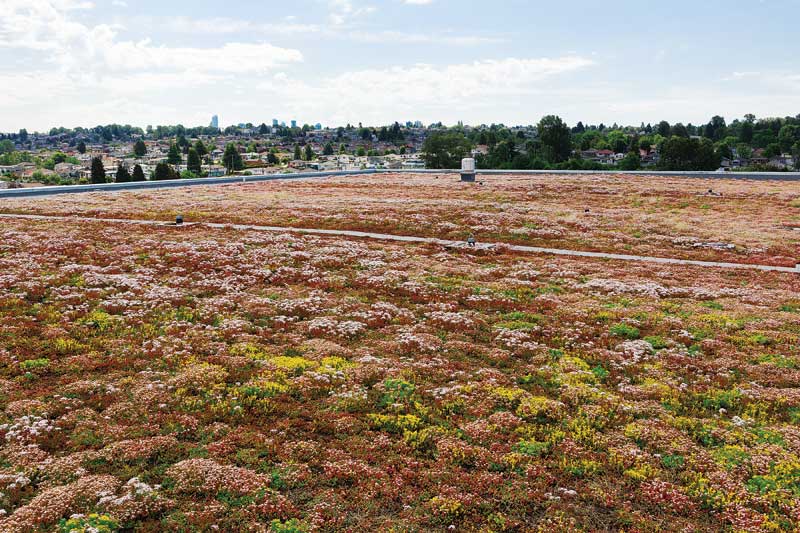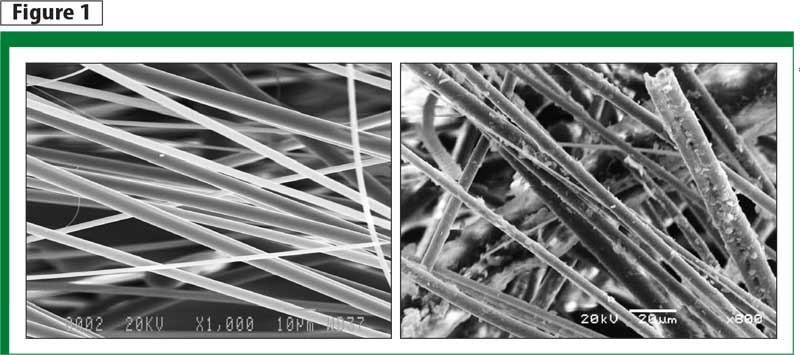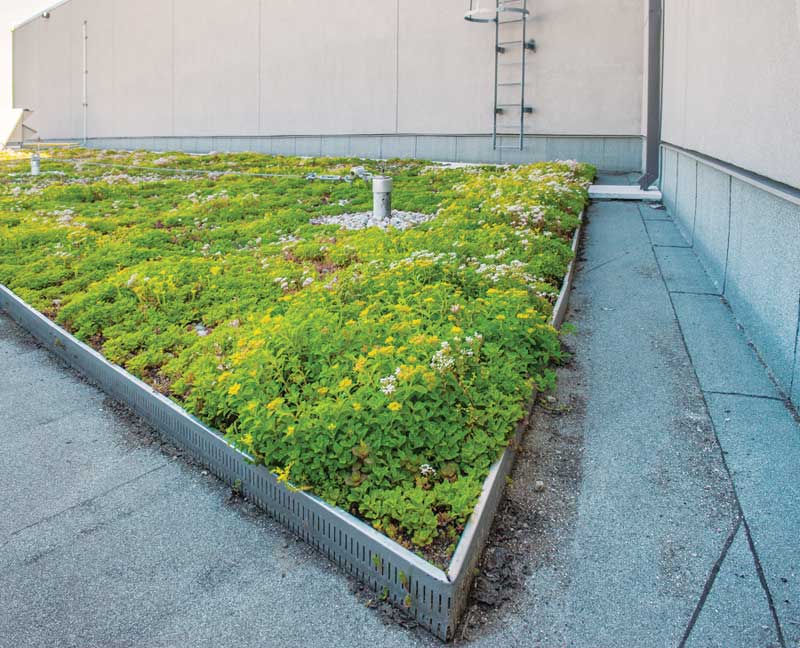Advancements in efficient stormwater management in vegetated roofing

Photo courtesy Terry Guscott/Next Level Stormwater Management
Categories of rock mineral wool
Various types of RMW are currently available, each complete with its own unique advantages, drawbacks, and properties.
Traditional binders
The most common mineral wool on the market is sprayed or bound with phenolic resin or diluted phenol-formaldehyde (PF) for dimensional stability. These binders also help make the product water-repellent. This type of mineral wool is typically used as insulation in the construction industry.
When traditional mineral wool is modified with a hydrophilic (or wetting) agent, it can be used as a growing media for hydroponic cultivation in a strictly controlled environment. If this type of mineral wool is used as an alternative to other growing media, it requires uniform conditions such as a greenhouse where usage cycles tend to be relatively short (i.e. from one growing season to five, in the case of ornamental plants). If it is exposed to any varying, uncontrolled climatic conditions (e.g. dry/wet periods, freeze/thaw cycles, or high/low temperatures) for longer periods, its water-holding characteristics will change significantly, resulting in decreased hydrophilic ability. In other words, cycles of drought or precipitation will negatively influence the material’s long-term performance and its water absorption capacity. This phenomenon likely occurs due to the hydrophilic agent rinsing out, which causes the initial hydrophobic character to prevail.
Therefore, traditional mineral wool is not ideal for outdoor applications such as vegetated roofing. Its hydrophobic propensity renders it an inconsistent and unreliable stormwater management product over time, unable to effectively sustain rooftop plants under significant stress in hot and dry seasons.
Formaldehyde-free binders
A new generation of mineral wool providing a solid alternative to the traditional variety has been invented and commercialized in the last decade. Bound together using a bio-based technology, this mineral wool is free from formaldehyde, phenols, and acrylics and uses no additional artificial colours, bleaches, or dyes. This reduces harmful manufacturing emissions and workplace exposures, improving the overall sustainability of buildings into which the product is incorporated.

Photos courtesy Institute Jožef Štefan
However, as with traditional mineral wool, bio-based binders will typically render the mineral fibres hydrophobic. A hydrophilic agent must be added to improve the hydrophilic capacity of the material. While mineral wool with bio-based binders will retain more water than phenol-based mineral wool, its long-term water absorption capacity decreases, as it does with the phenol-based variety, due to the flushing of the hydrophilic agent during periods of drought and precipitation.
Needled or binderless innovation
The most recent advancement in this industry is the manufacture of needled mineral wool—a non-petroleum-based and formaldehyde-free alternative. The needling process provides dimensional stability without the use of any binders—mineral wool is formed by a mechanical interconnection of pure mineral fibres.
This process forms a structurally stable, lightweight, and porous material with longer fibres (Figure 1) that can maintain excellent water-holding properties. It is consistently hydrophilic, even after varying weather cycles throughout the year. The material can hold 90 per cent of its volume in water. When wet, the majority of the retained water is easily available for plants’ uptake. (This was tested by pH curve. The authors can provide data upon request.) A minimum of 10 per cent oxygen is left in the needled mineral wool, enough to support the oxygen levels in the root zone and, therefore, healthy roots. The material is inert, with chemically stable fibres. On the left side of Figure 1, the condition of fibres three years after installation is shown with soil particles attached.
The hydrophilic characteristics of needled RMW can offer long-term stability, as nothing rinses away. The physical attraction between fibres and water remains the same throughout the lifetime of the product.

Photo courtesy Next Level Stormwater Management
This material is ideal for vegetated roofs, as it:
- is lightweight;
- can supplement or, in some cases, replace heavy growing media;
- can act as a water reservoir while supporting plant health;
- achieves more credits under the Leadership in Energy and Environmental Design (LEED) program (The material contributes to eight additional points under LEED v4. These include credits in the Sustainable Sites [Protect or Restore Habitat, Open Space, Rainwater Management, and Heat Island Reduction], Energy and Atmosphere [Optimize Energy Performance], Materials and Resources [Environmental Product Declarations], and Indoor Environmental Quality [Thermal Comfort and Acoustic Performance] categories.); and
- performs exceptionally and reliably as a rooftop stormwater management tool throughout the lifespan of the vegetated roof (as seen on Sweden’s Karolinska University Hospital, Rentenversicherung headquarters in Berlin, and various projects throughout Baltic and Scandinavian countries).
Needled mineral wool is available as a hydro blanket with a density of 130 to 145 kg/m3 (286 to 319 lb/35 cf). It also is available as hydro cubes (20 mm x 20 mm [0.8 x 0.8 in.]) and as hydro flocks (3 to 20 mm [0.1 to 0.8 in.]). Cubes and flocks are added to a traditional growing medium and contribute to better soil structure, water-holding capacity, and aeration. The retained rainwater inside the hydro cubes or hydro flocks is easily available for plant uptake, improving plant survivability. Cubes and flocks are especially recommended for patios, terraces, and landscaping applications.


